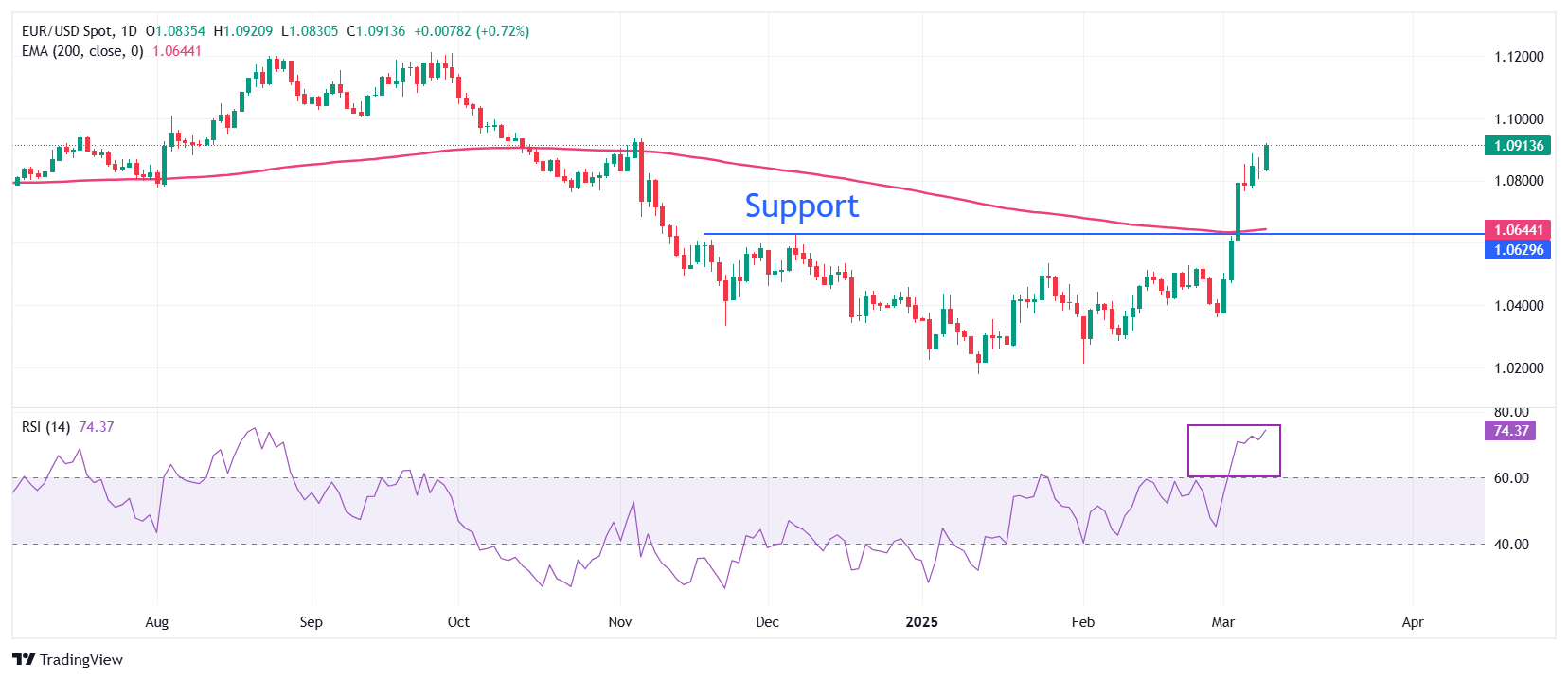- EUR/USD climbs above 1.0900 as the US Dollar weakens further amid rising concerns over the US economic outlook.
- Euro strengthens after Germany’s Green Party agrees to support defense spending plans.
- Investors focus on upcoming US JOLTS Job Openings (January) and CPI data (February) for further market direction.
The EUR/USD pair surged past 1.0900 during European trading hours on Tuesday, reaching a fresh four-month high. The pair gained strength as the US Dollar (USD) continued to weaken, weighed down by growing concerns over an economic slowdown in the United States (US). The US Dollar Index (DXY), which tracks the Greenback’s value against six major currencies, dropped to a four-month low near 103.30.
Investors have been selling the US Dollar amid fears that the US economy could experience disruptions due to President Donald Trump’s “America First” policies. While these policies were initially seen as inflationary and pro-growth, market participants are now concerned about economic instability, particularly the effects of higher tariffs on businesses. Many business owners are expected to pass on the burden of tariffs to consumers, leading to higher prices and weaker demand. This has intensified fears of a Trump tariff-induced slowdown, increasing the likelihood that the Federal Reserve (Fed) will cut interest rates in May. According to the CME FedWatch tool, market expectations for a rate cut have risen to 51% from 37% in just one day.
For further insight into the Fed’s monetary policy direction, investors are closely watching the US Consumer Price Index (CPI) data for February, scheduled for release on Wednesday. While inflation is expected to decelerate, it will likely remain above the Fed’s 2% target, influencing future rate decisions.
Additionally, traders are awaiting the US JOLTS Job Openings data for January, set to be published at 14:00 GMT on Tuesday. Economists anticipate that US employers posted 7.75 million new jobs, slightly higher than 7.6 million in December.
On Friday, Fed Chair Jerome Powell addressed an economic forum at the University of Chicago Booth School, stating that the Fed’s policy is not on a “preset course” and could remain restrictive for longer if inflation progress stalls.
With the US Dollar under pressure and traders positioning ahead of key economic data releases, EUR/USD maintains a strong bullish trend, holding firm above the 1.0900 level.
Daily Digest Market Movers: EUR/USD Strengthens as Euro Outperforms
- The EUR/USD pair continues to gain momentum, supported by the Euro’s (EUR) outperformance against its peers. The Euro advanced amid growing expectations that the Franziska Brantner-led German Green Party will back the proposed defense spending deal, set for discussion on Thursday. Hopes for an agreement on Germany’s borrowing limit increased after Brantner’s positive remarks in an interview with Bloomberg on Tuesday during European trading hours.
- Brantner, co-head of the Green Party, stated, “Of course, we are ready to negotiate. The situation is dire in Ukraine, and we really need Europe to speed up its own defense spending.” Previously, the Greens had opposed restrictions on debt reforms, but Brantner’s latest comments suggest a potential shift. On Monday, she also emphasized that the party would not allow Friedrich Merz, the likely next Chancellor, and Social Democratic Party (SPD) co-leader Lars Klingbeil, to “abuse a difficult European security situation.”
- The Euro has been performing strongly over the past two weeks, fueled by speculation that an expansion of Germany’s fiscal spending through loosening the debt brake could help stimulate its struggling economy, which has faced contractions over the past two years.
- Additionally, Germany’s increased spending plans have prompted traders to reassess expectations regarding the European Central Bank’s (ECB) interest rate policy. The ECB has already implemented two rate cuts this year, and markets had fully priced in two additional cuts by summer. However, with renewed optimism over economic resilience and concerns about potential US tariffs, traders are reconsidering their monetary policy outlook for the Eurozone.






